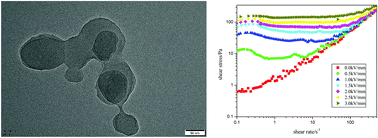Titanium oxide-coated titanium-loaded metal organic framework (MOF-Ti) nanoparticles show improved electrorheological performance
Abstract
Uniform small-sized MOF-Ti nanoparticles were prepared by a one-step hydrothermal method, and then a 5–10 nm TiO2 shell was coated onto them by using the sol–gel method, and MOF-Ti/TiO2 with a specific surface area of 50.2 m2 g−1 was successfully prepared. The nanoparticles were characterized using scanning electron microscopy (SEM), transmission electron microscopy (TEM), X-ray powder diffraction (XRD), Fourier transform infrared spectroscopy (FT-IR), nitrogen adsorption–desorption isotherms (BET), and X-ray photoelectron spectroscopy (XPS). The above-analyses have elaborated the experimental study of their morphology, elements, and energy of organic functional groups. At the same time, through the use of a high-voltage rotary rheometer to test their rheological properties, the analysis of shear stress, ER efficiency, shear viscosity, etc. was performed and their dielectric constant and dielectric loss were studied by using a broadband dielectric spectrometer. Finally, we found that MOF-Ti/TiO2 is a new core–shell nanocomposite particle with a small particle size and good electrorheological properties.



 Please wait while we load your content...
Please wait while we load your content...